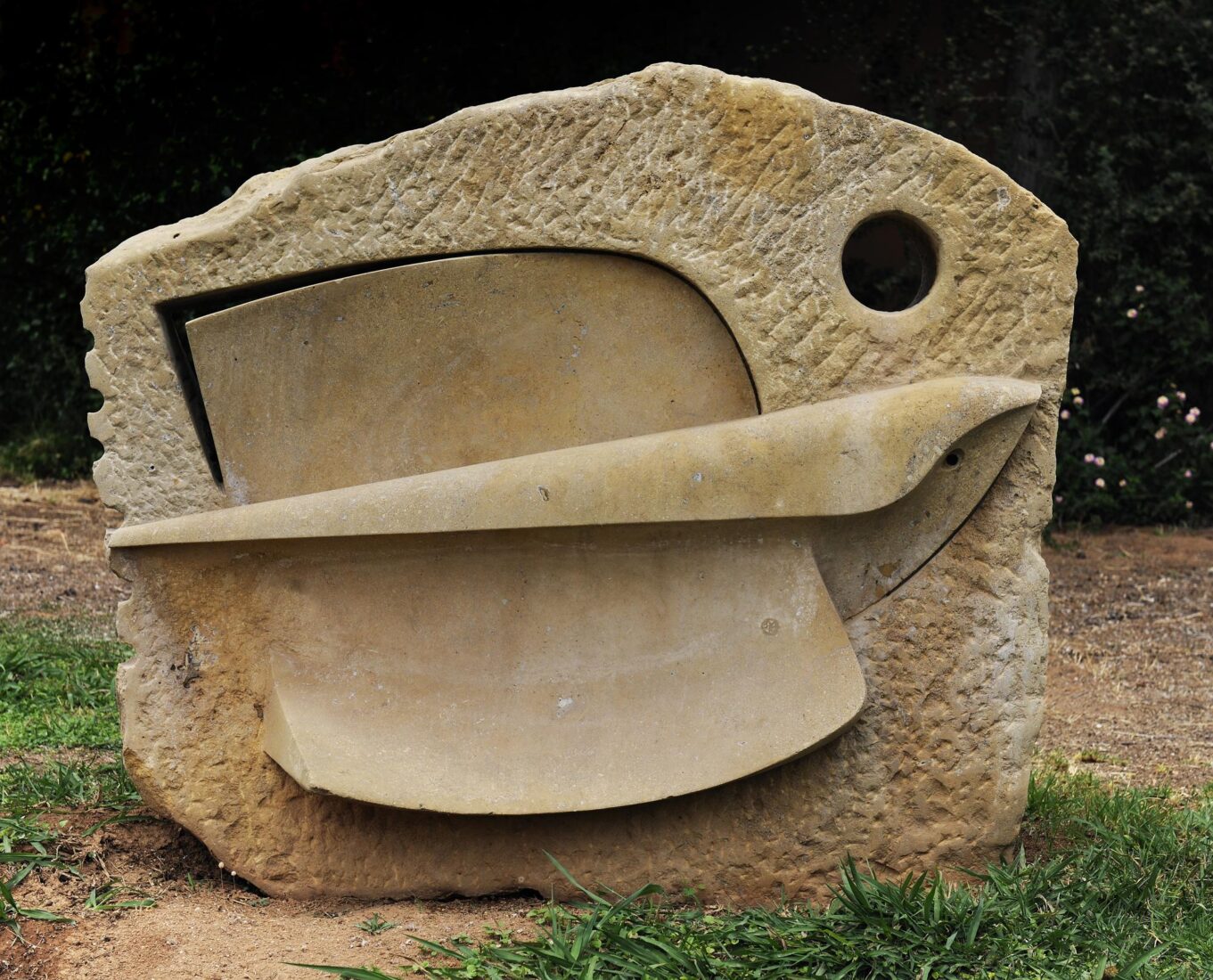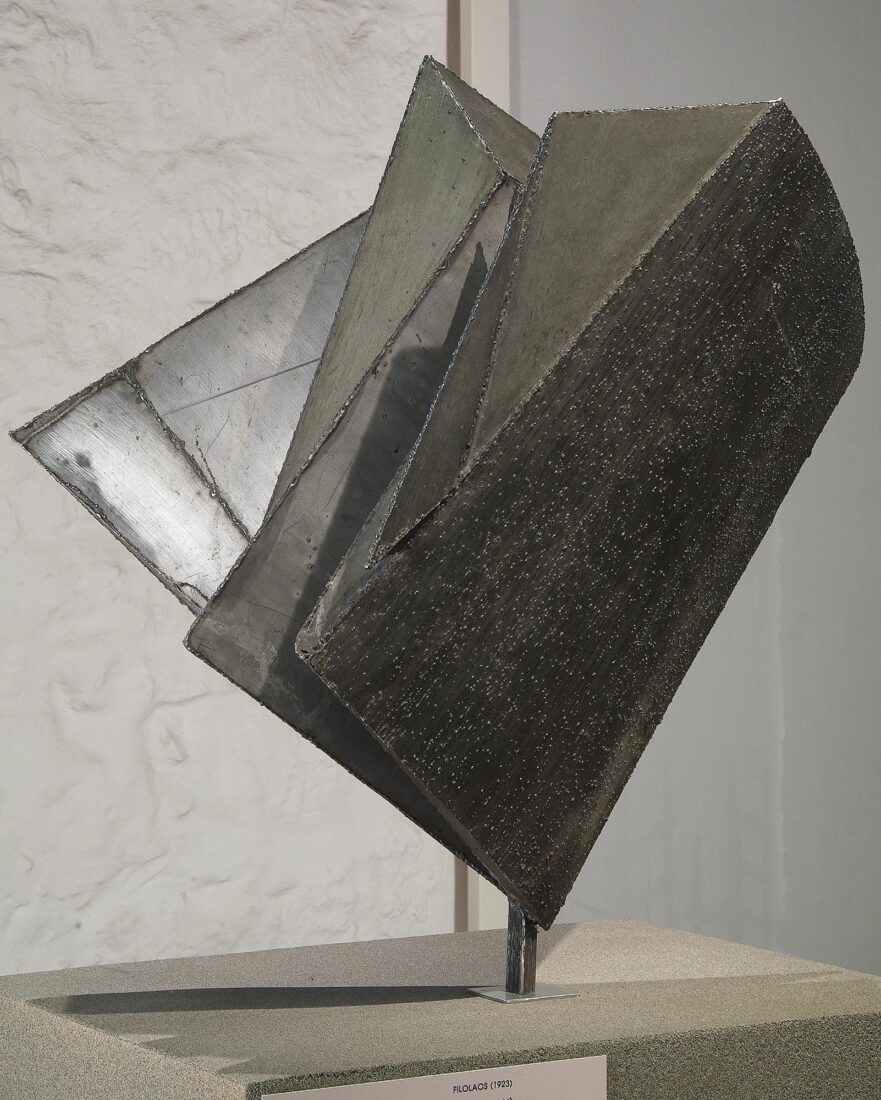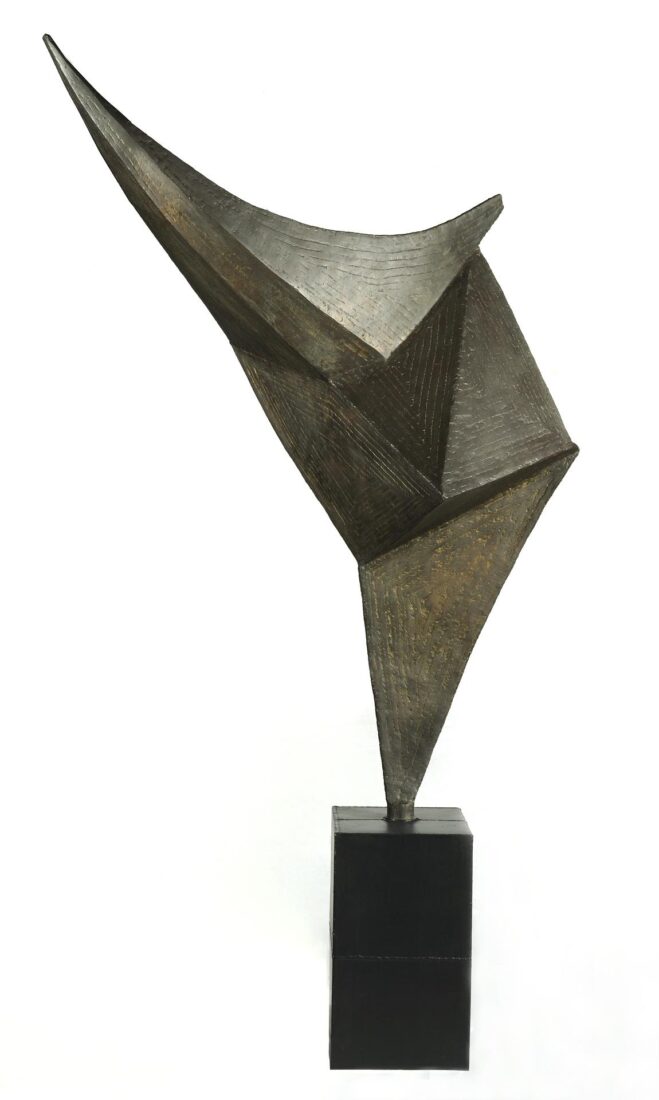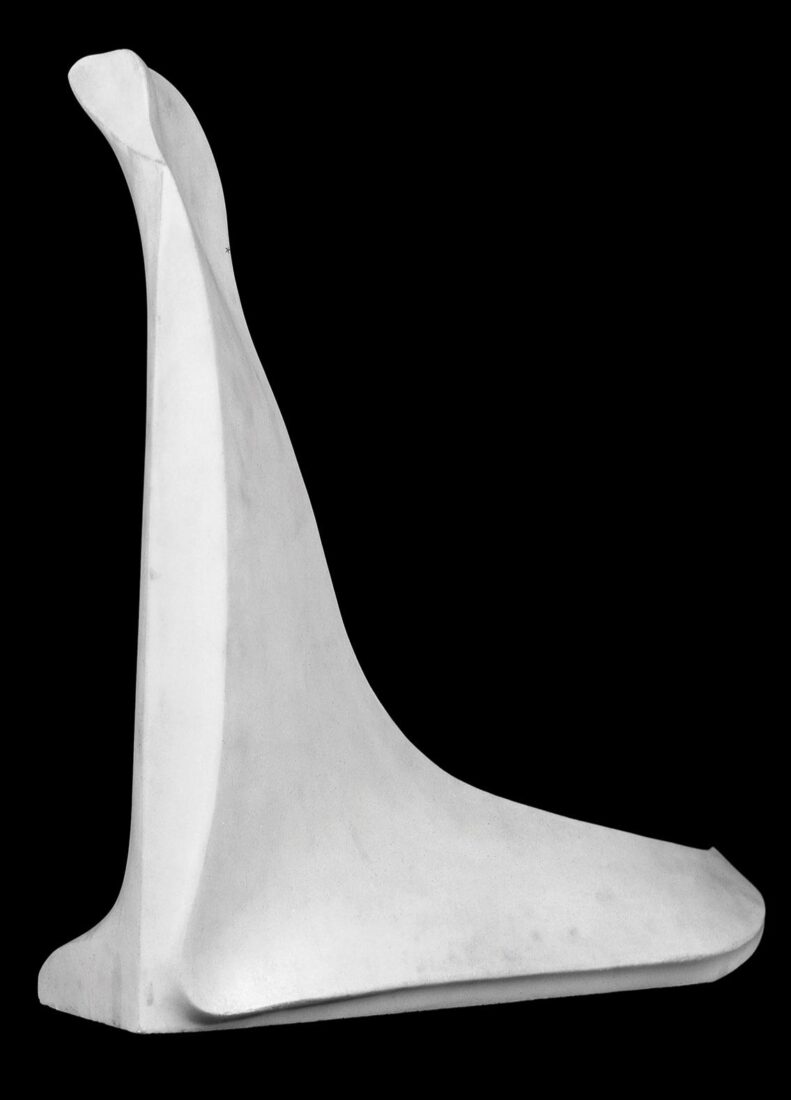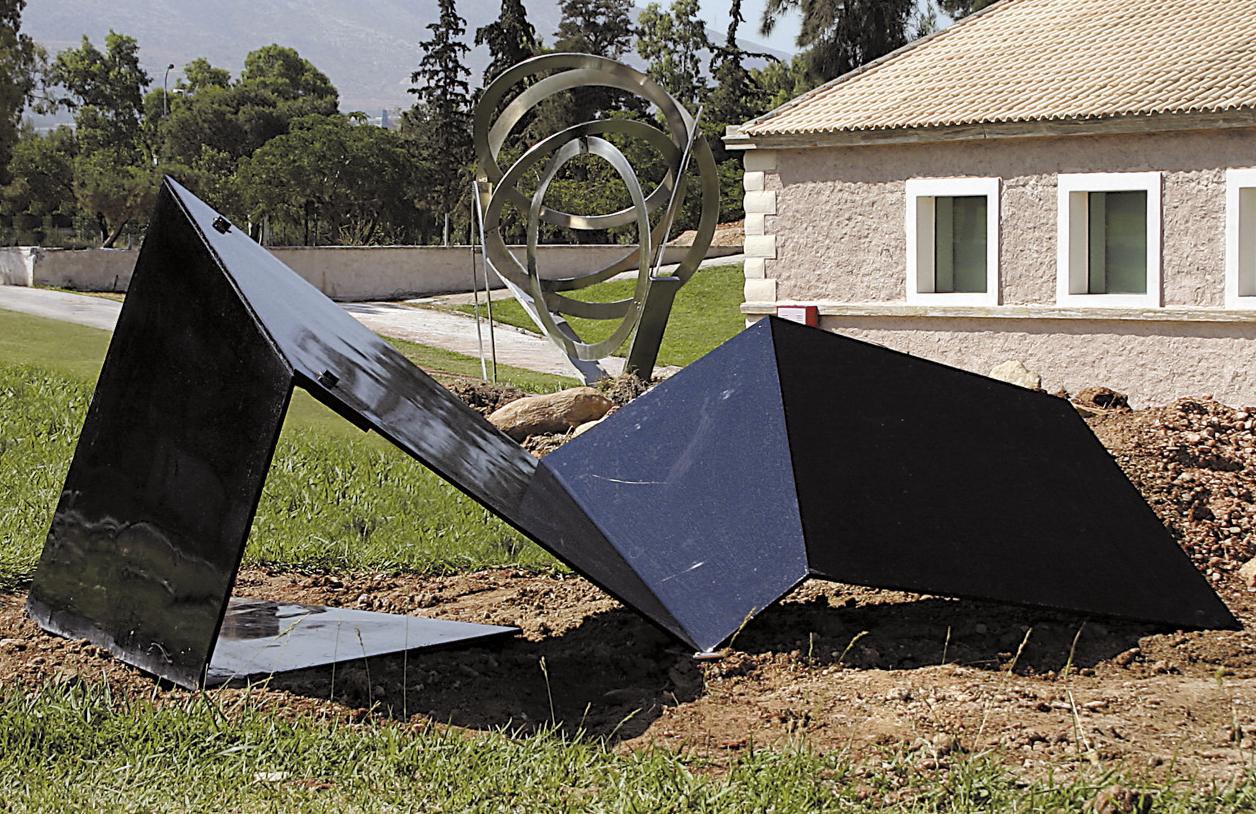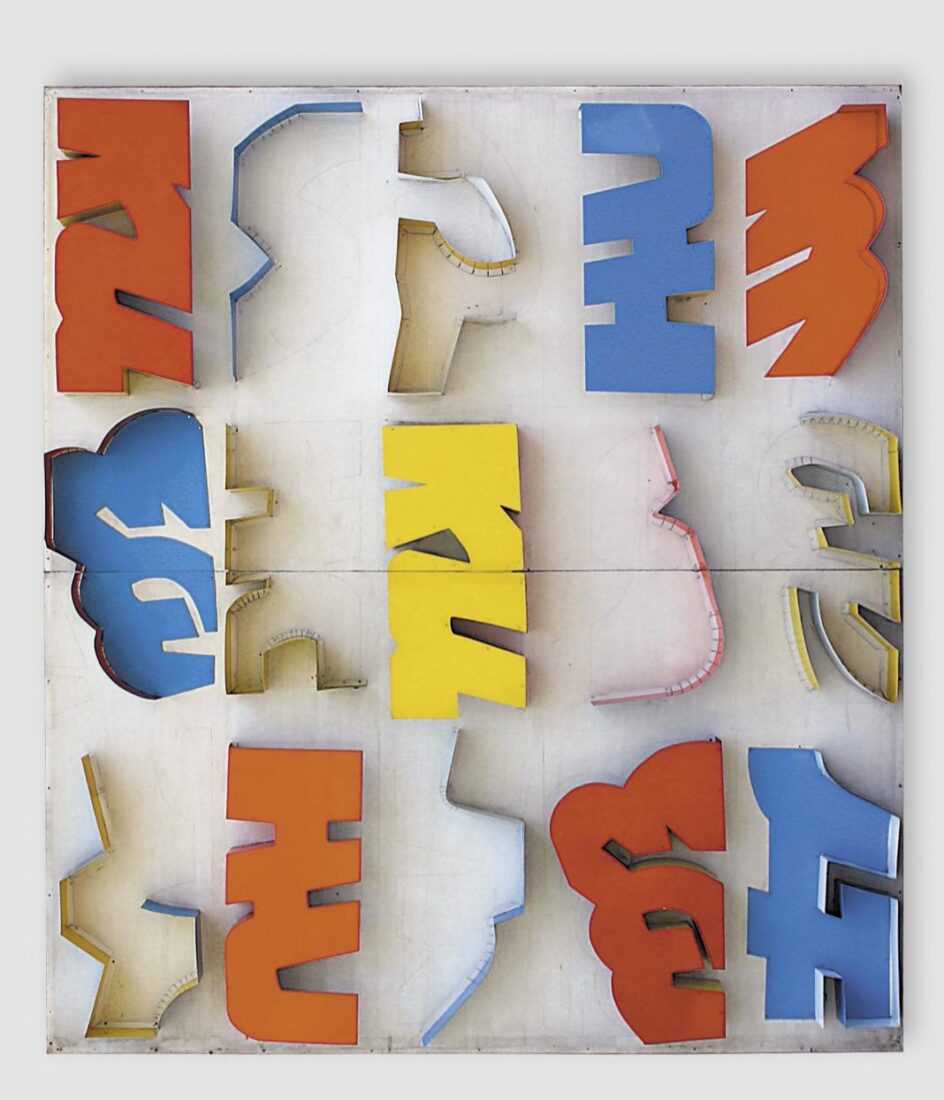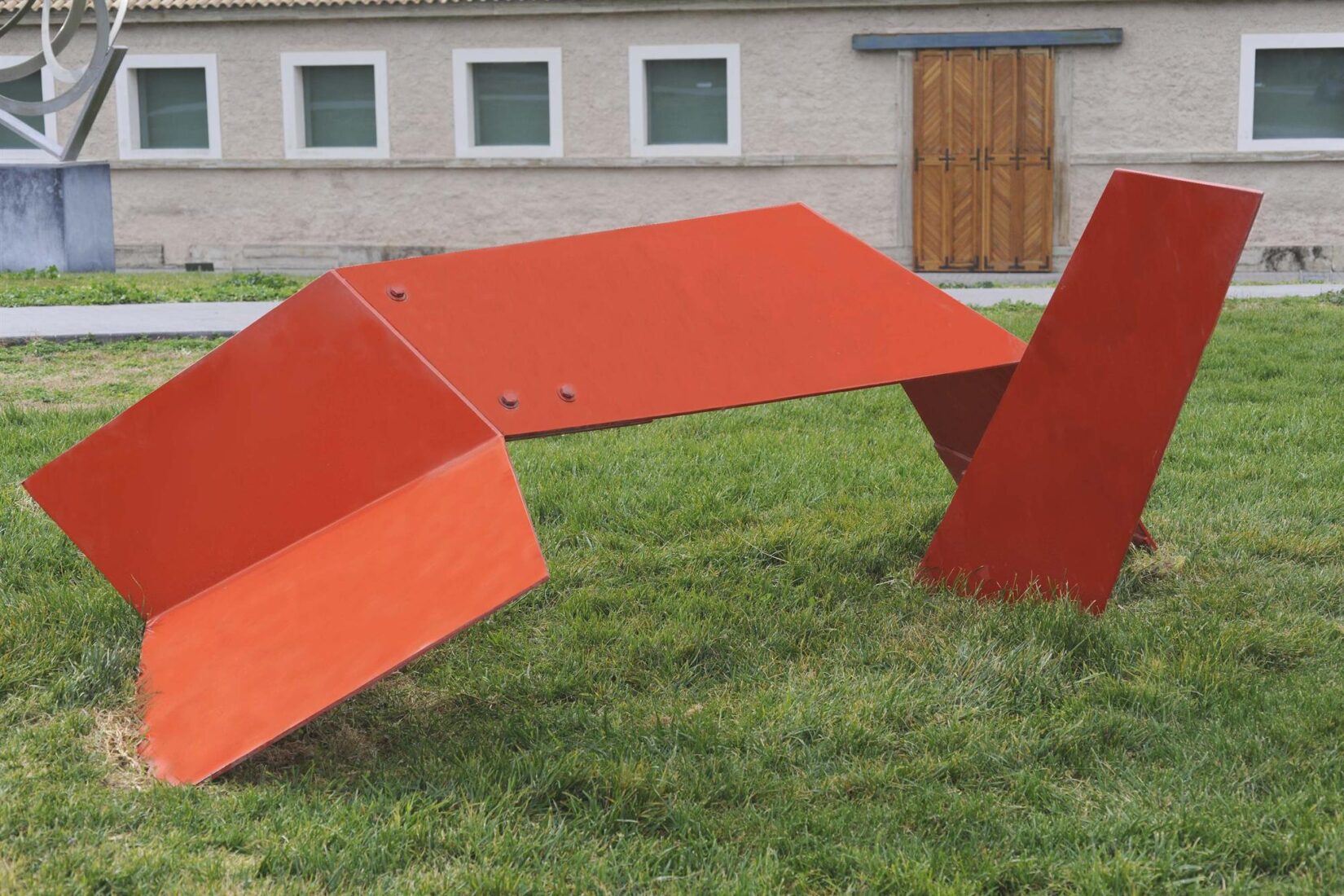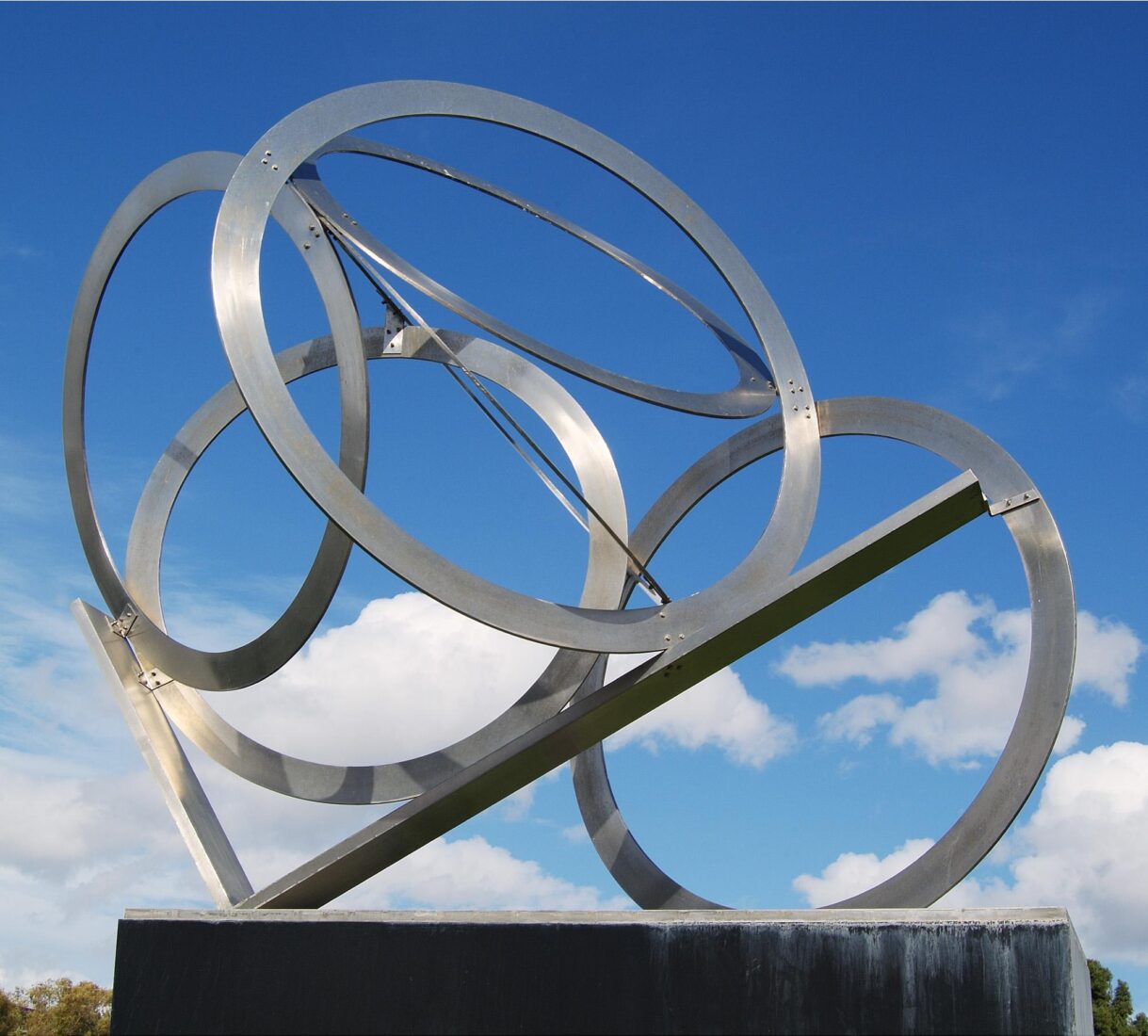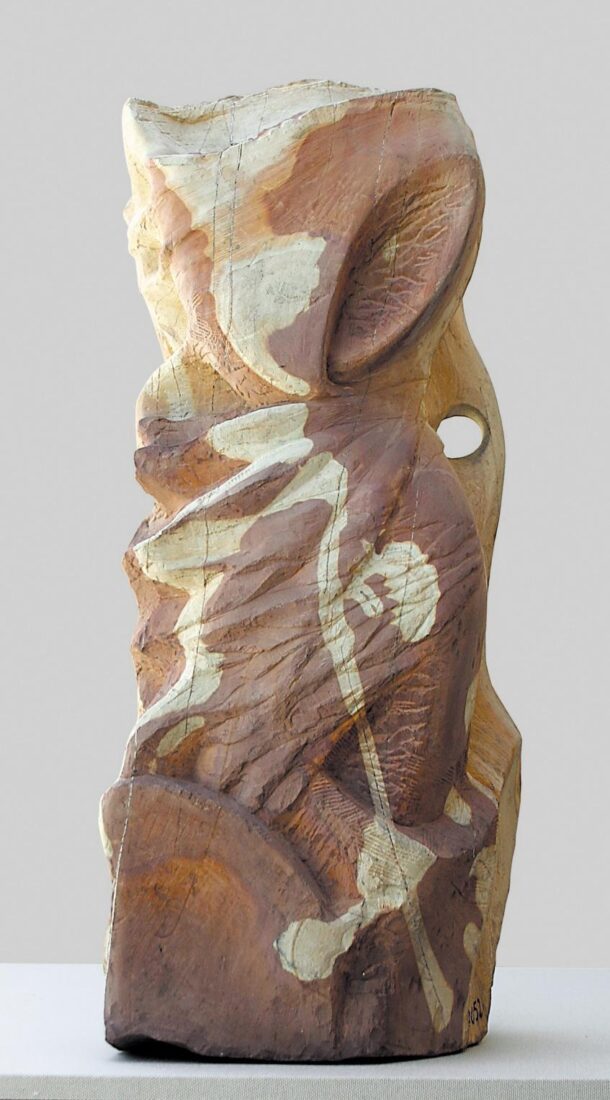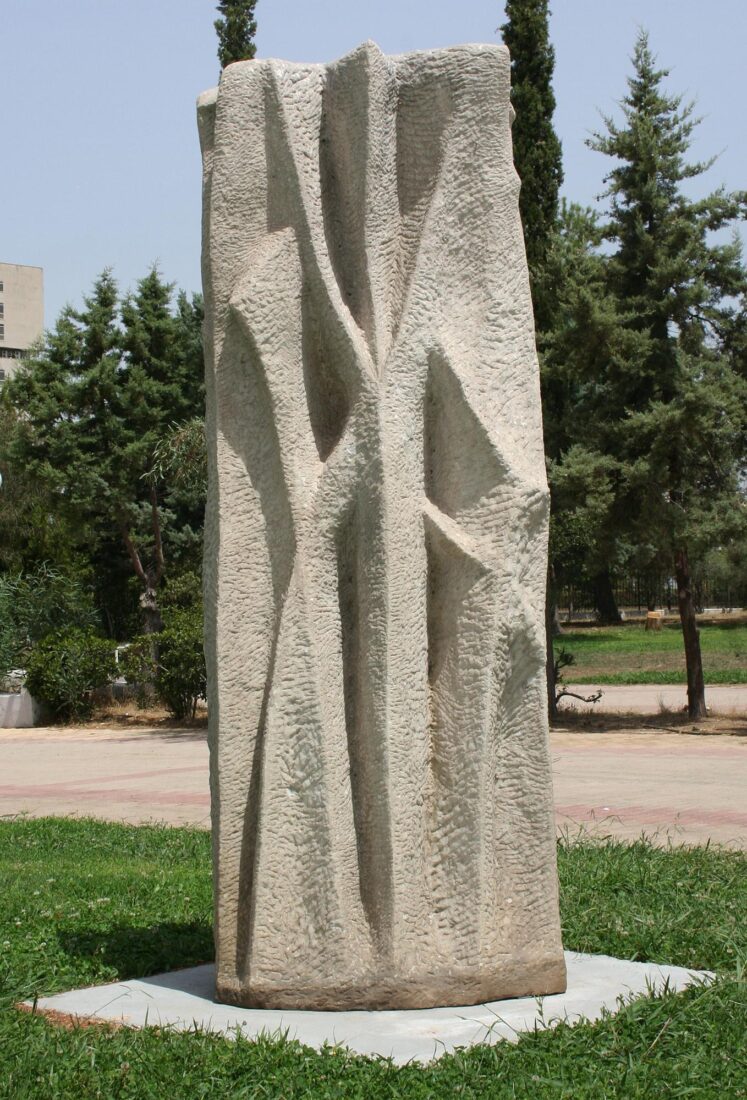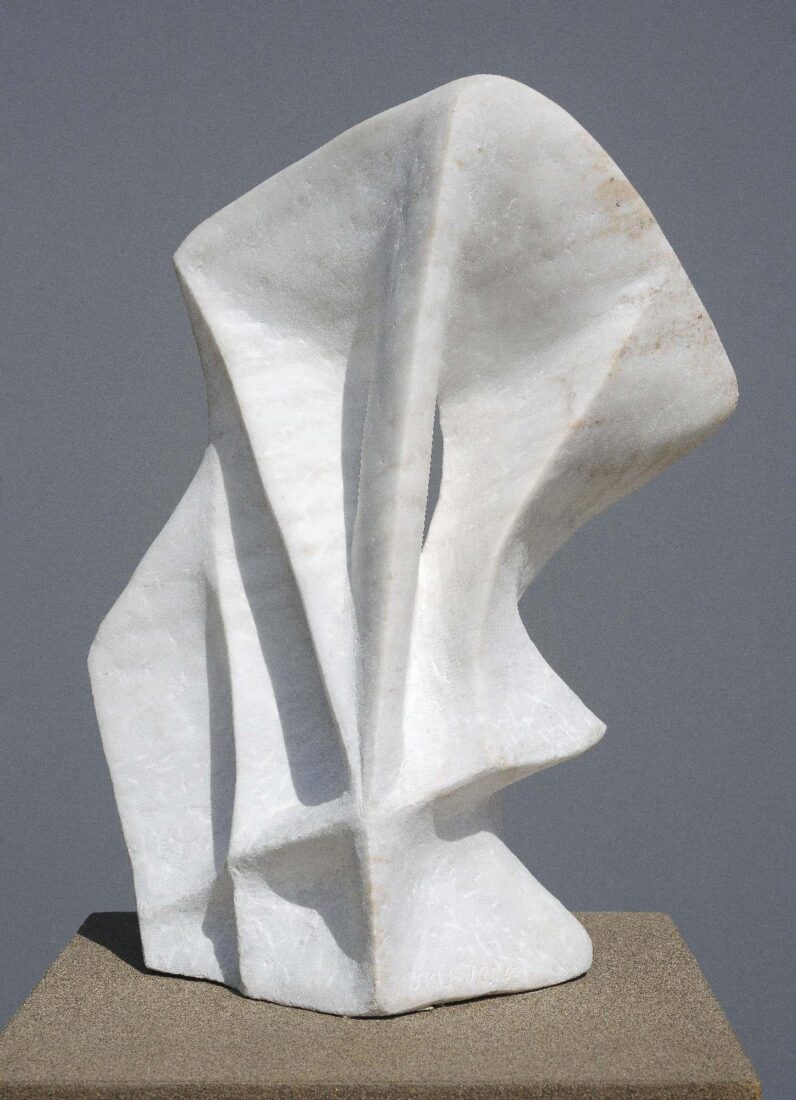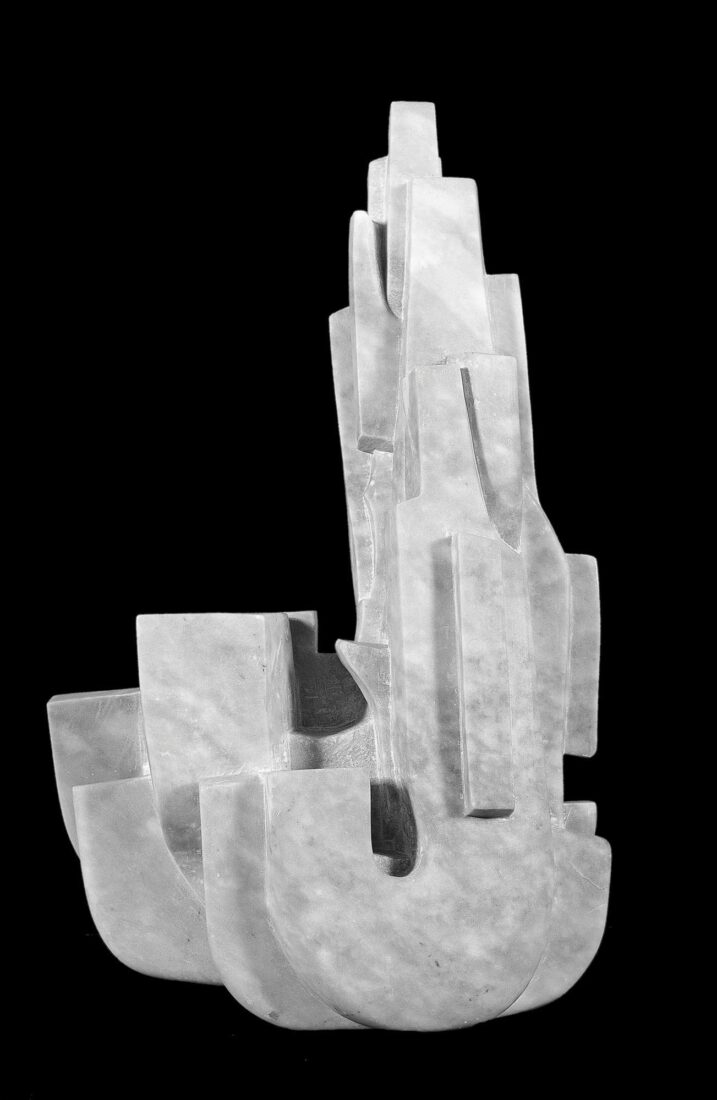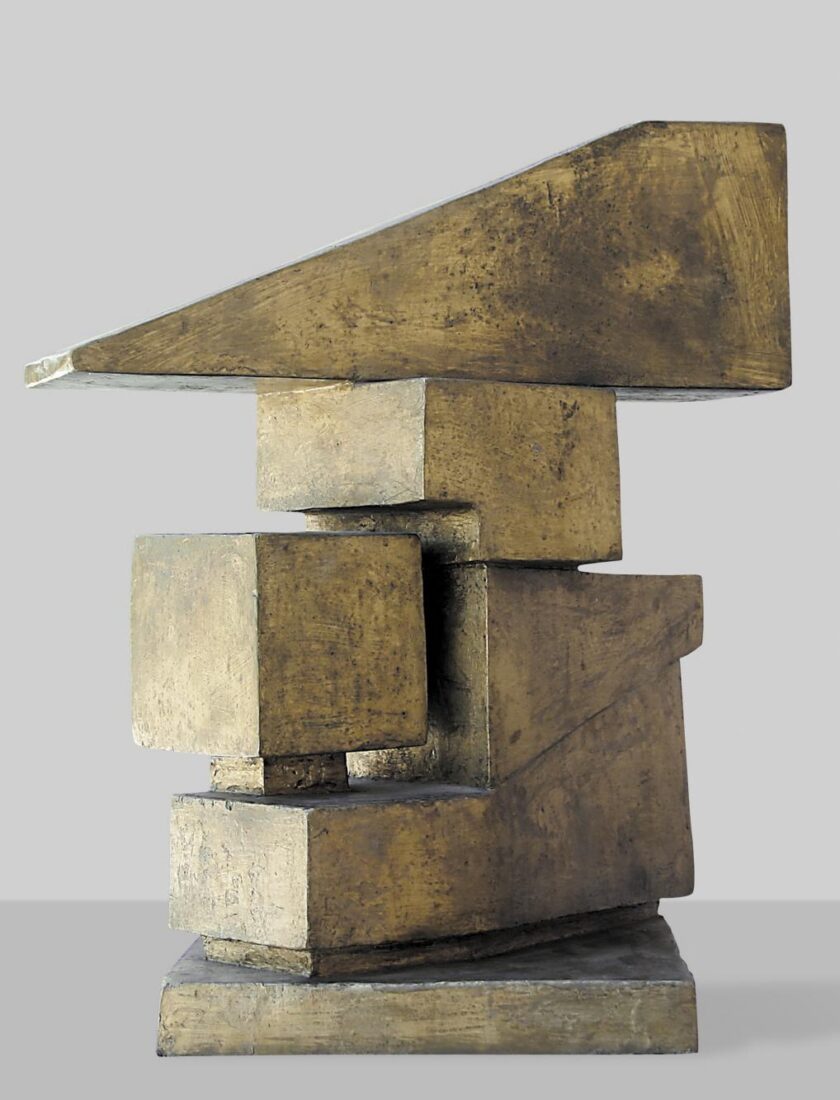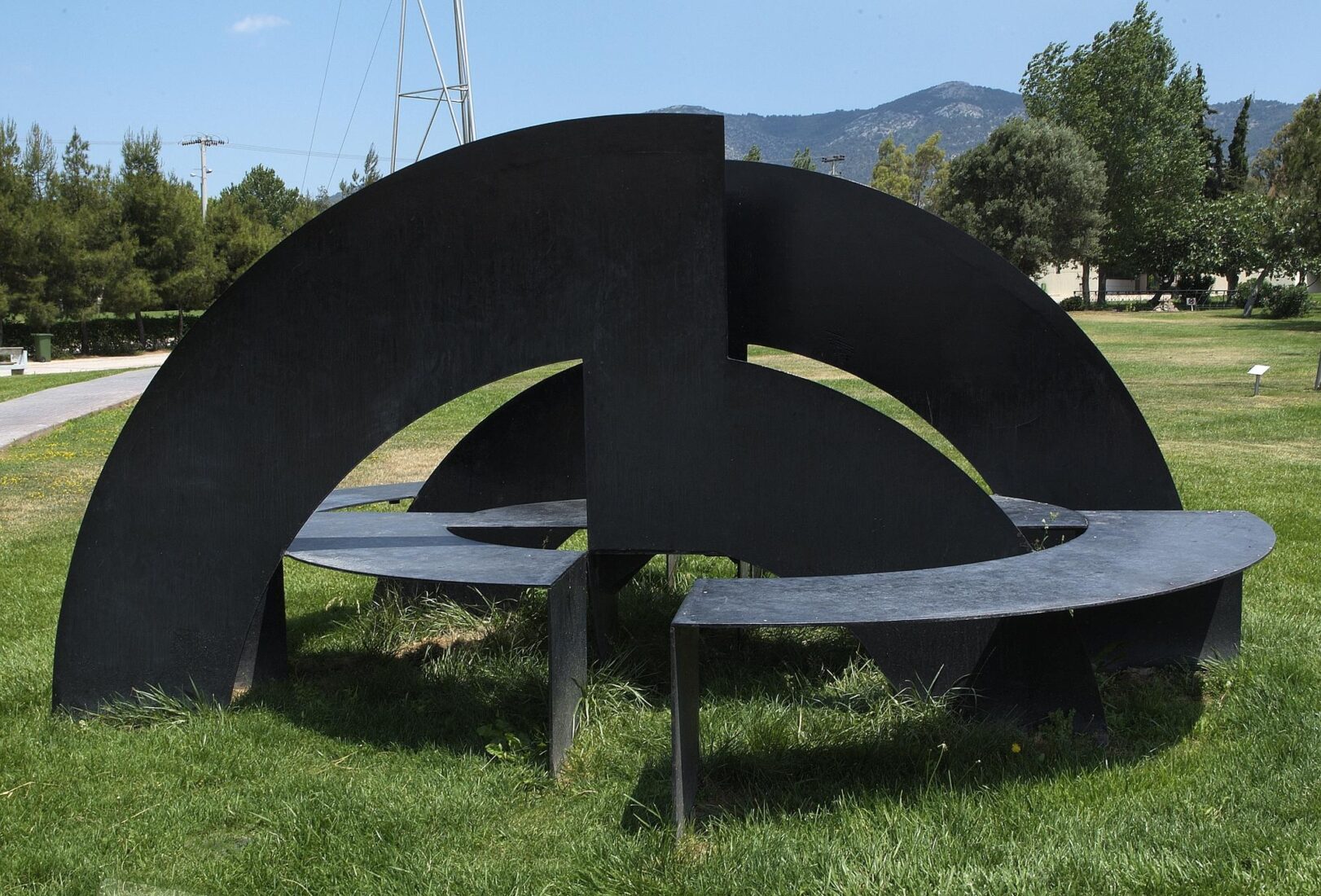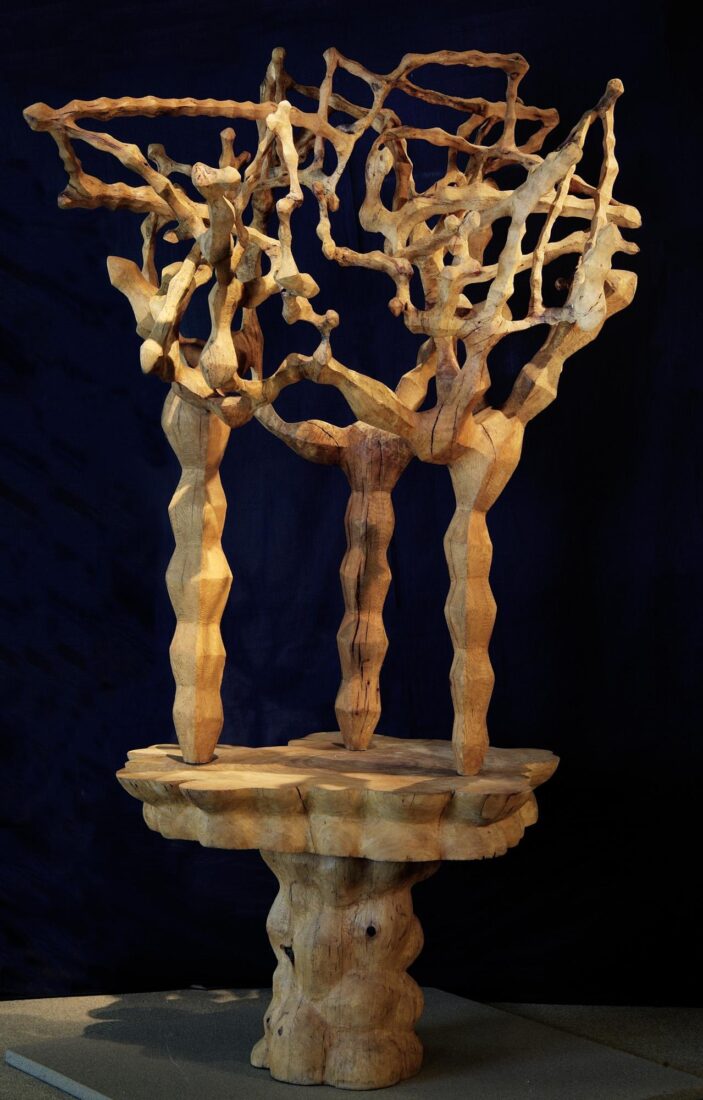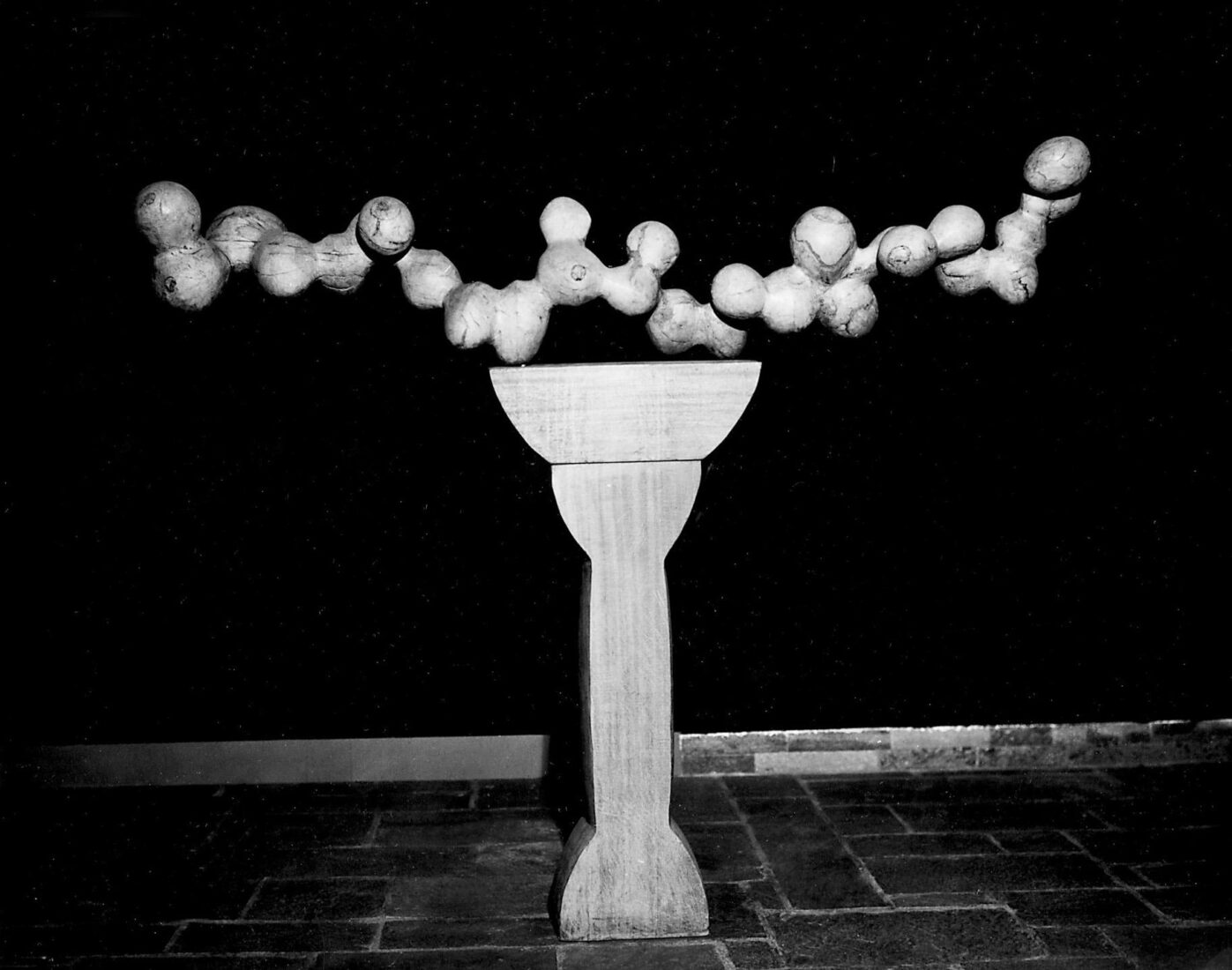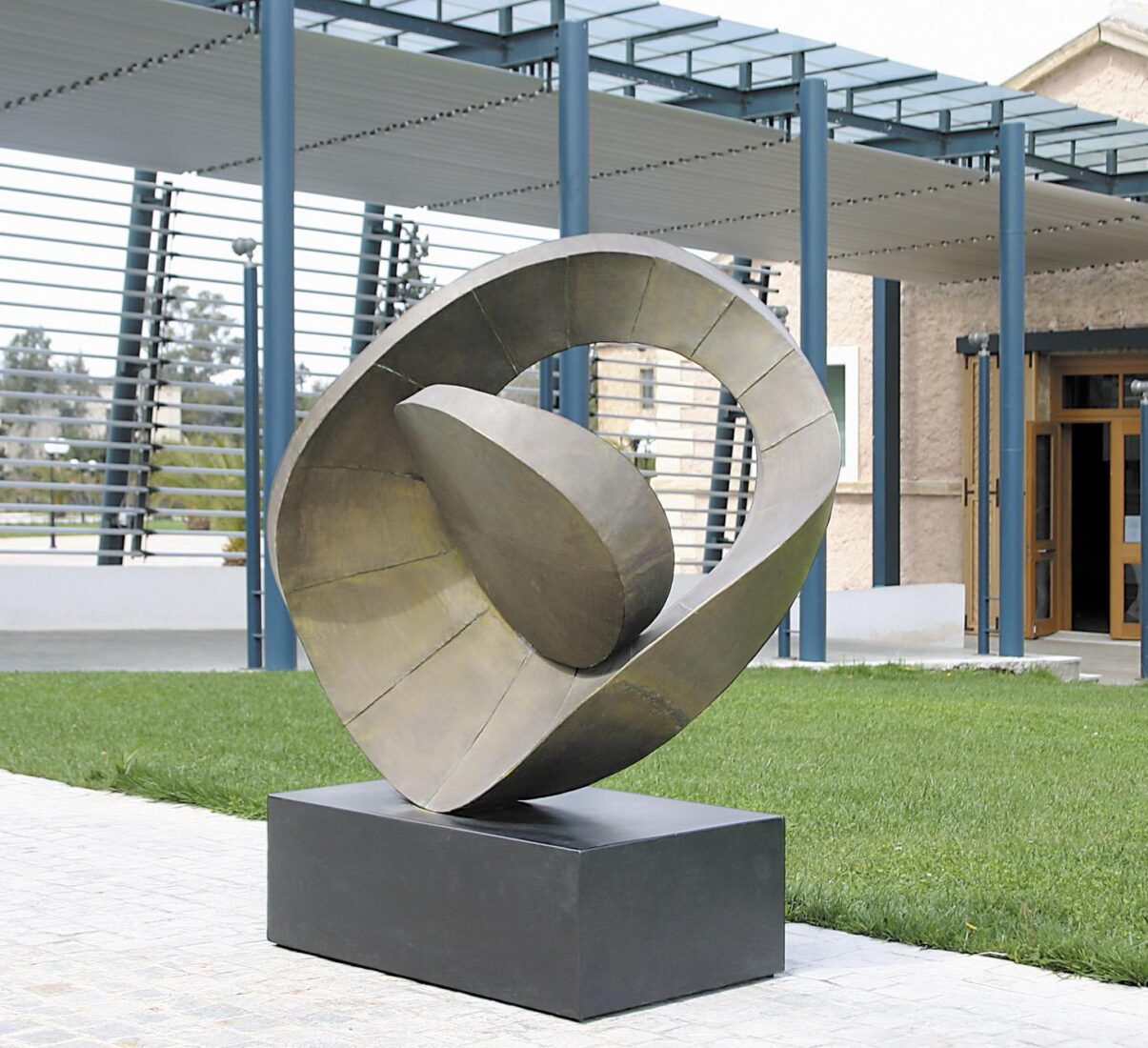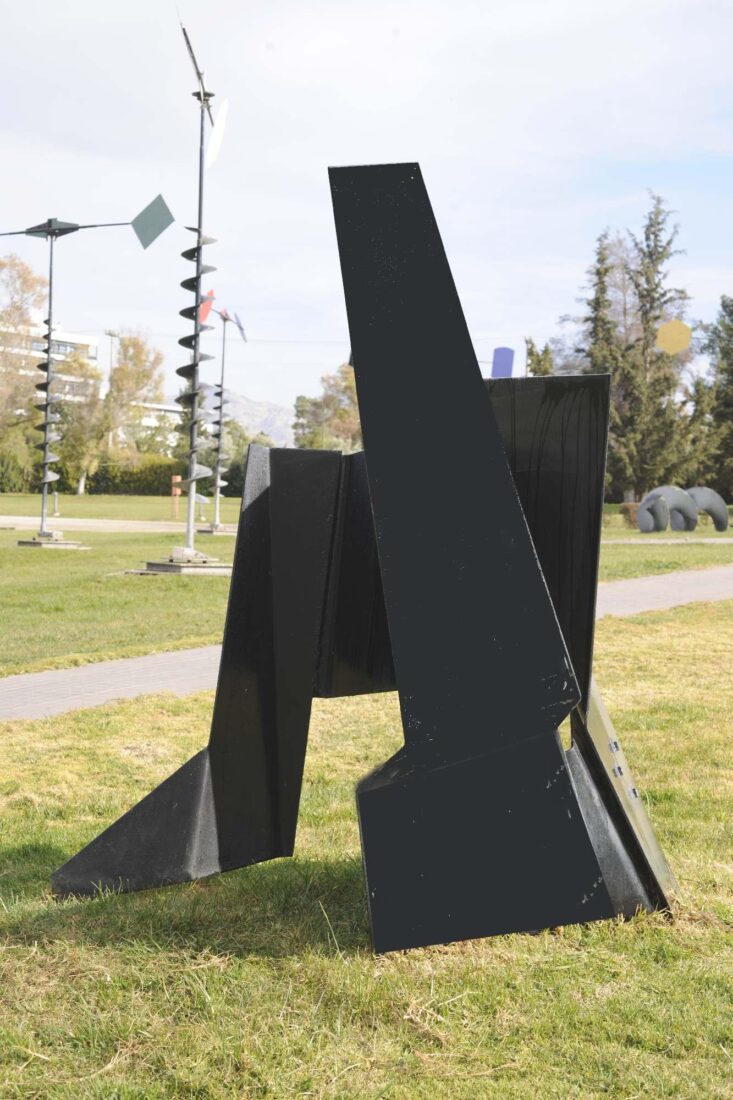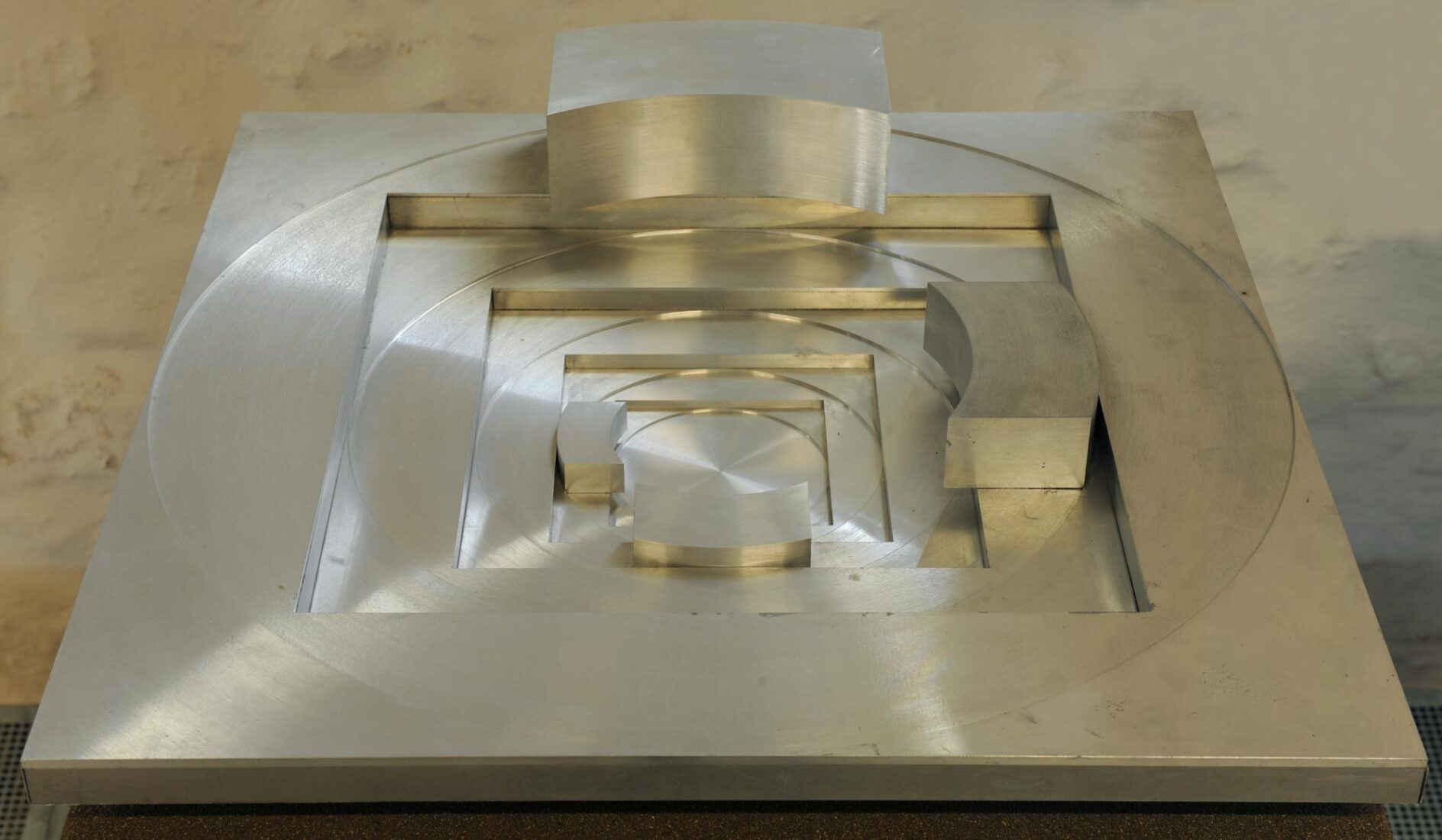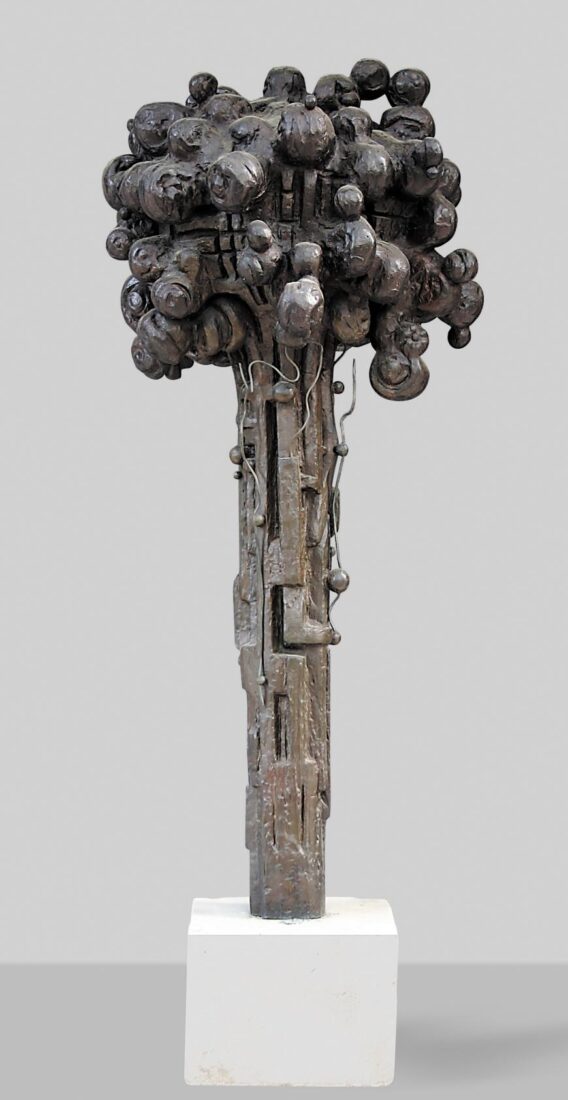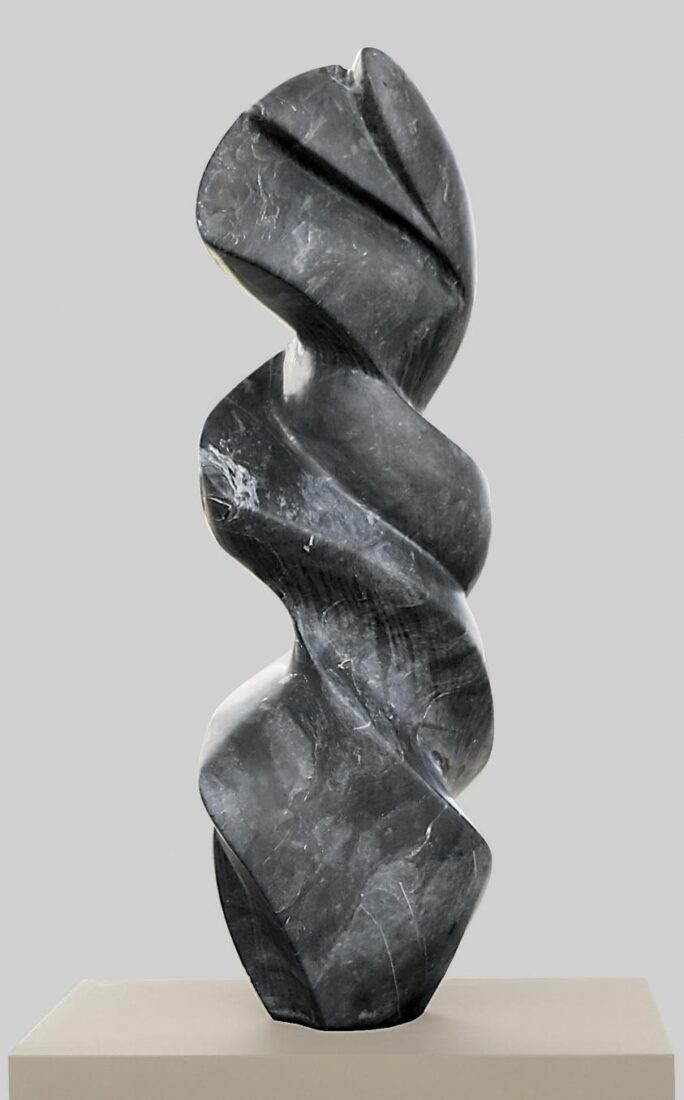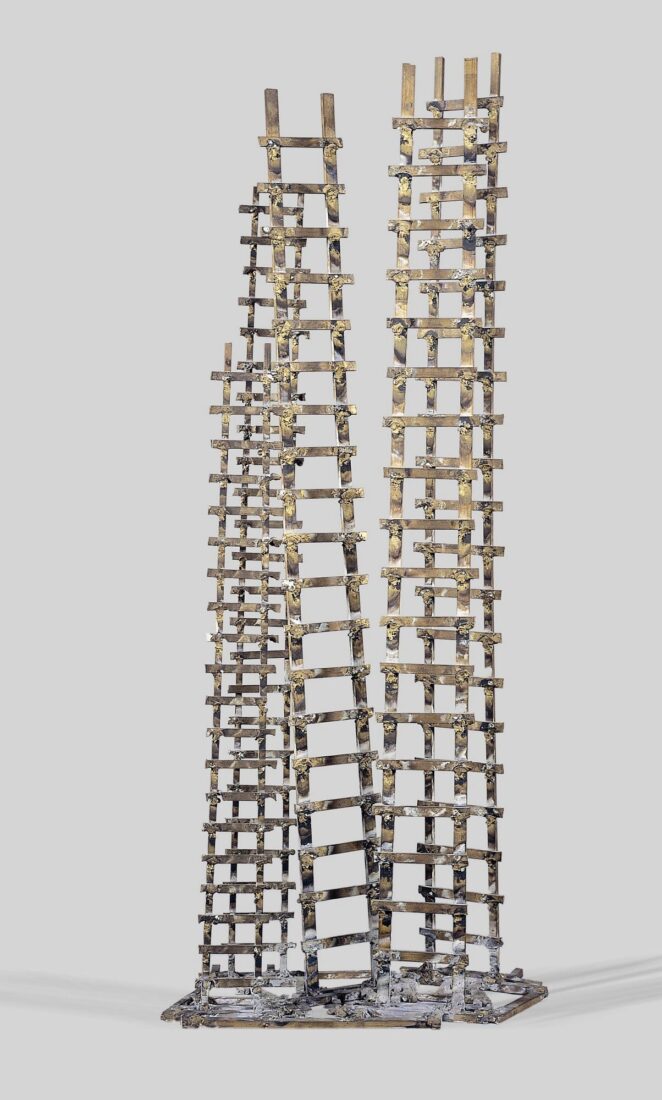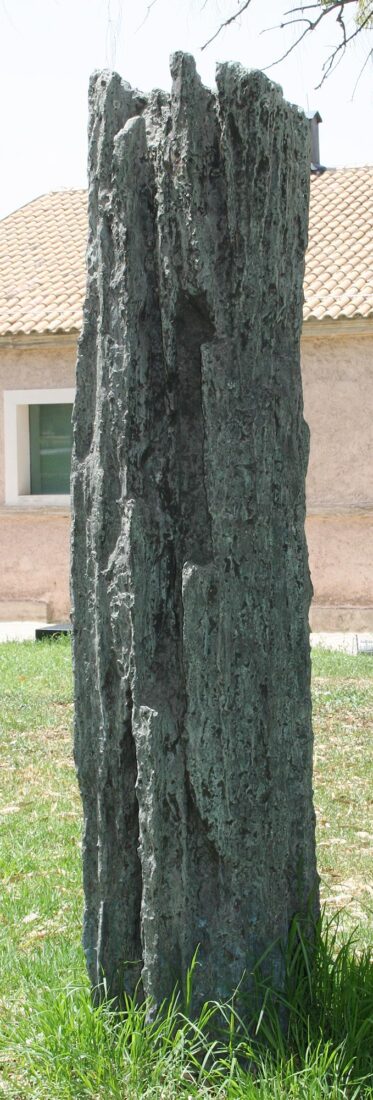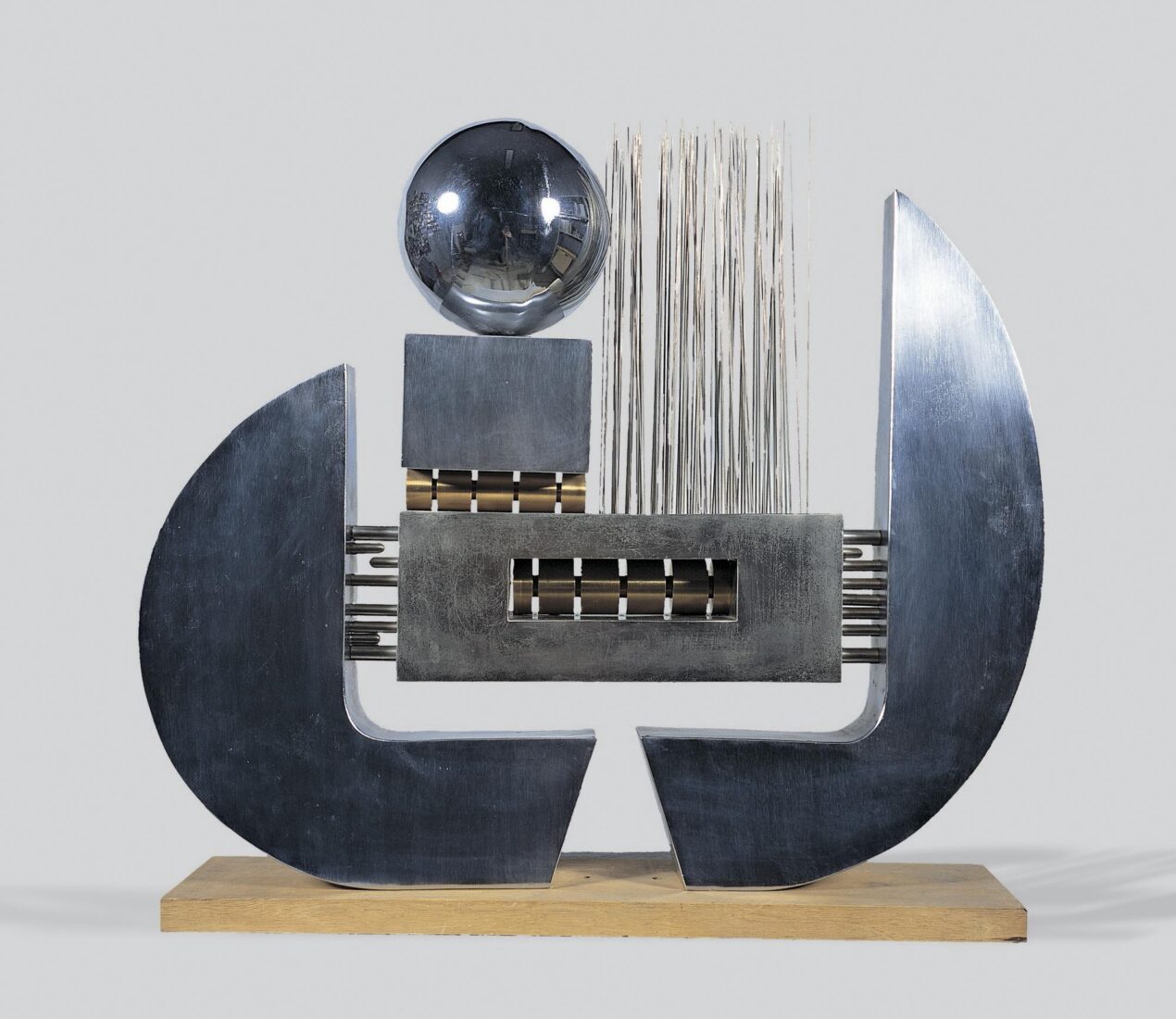Dionyssis Gerolymatos is one of the few sculptors still working in the traditional sense, that is, he works with hard materials – stone, marble, cement. His thematic field includes works taken on commission as well as compositions of free inspiration, small or large. Since his student years, he has made use of extreme schematization, which, in his later works, is sometimes transformed into abstraction. Employing an expressionistic or surrealistic style, he gives form to thoughts, feelings, and impressions, while frequently poetry is also a motivation behind compositions through which he illustrates verses.
The “Stone of Patience” is a characteristic example, where a line from George Seferis is taken as the title of a work, while other of the poet’s verses are engraved on the side. Using stone, a hard material, Gerolymatos combines the external volume, left deliberately rough, with a piece ground smooth which then takes on the schematic form of a bird with open wings – symbol of freedom and hope – and thus creates his own image, an optimistic one, for the poetic words.
A Greek of the diaspora, Philolaos settled in Paris after the war. His liberation from the academic spirit of the Athens School of Fine Arts is obvious even in his earliest work, despite the fact he was still working in the field of representation; he soon consolidated his quests and advanced on to abstraction. The result was compositions based on geometric forms or, in certain cases, on expression by means of non-figurative shapes, in which the figurative elements are limited to a completely schematic rendition. A chance event at the end of the Fifties, when he was trying to give form to a work in iron, revealed to him a physical tendency of the material to undergo centrifugal divergence, leading him to the utilization and the combination of the diagonal with the vertical axis. Thus, using stone, wood, lead, iron and, above all, stainless steel and beton lave, he made compositions such as “The Prow”, which are balanced on vertical and inclined levels, while at the same creating the impression of a potentially revolving movement.
Lazaros Lameras was among the vanguard of abstraction in Greece. His stay in Paris in 1938-1939 played a definitive role in this choice.
He created his first abstract works in the period 1945 to 1948, among which was “Penteli”. The work originally carried the poetic title, “Penteli in Ecstasy” and as such was shown in the first postwar Panhellenic exhibition of 1948. In fact, it was the first abstract sculpture to be formally exhibited in Greece.
The inspiration for the piece was the mountain in Attica that had provided the marble for many important works of sculpture dating back to antiquity. Lameras has carved a small composition that combines vertical and horizontal motifs with gentle curves and an almost perfectly smooth surface, thus arriving at a pure form that echoes the enterprise of Constantin Brancusi.
Frosso Michalea chose to express herself through abstraction since, even during her brief stint doing figurative depictions of the human figure, she used strong schematization. She made use of different materials, such as marble, wood, and stone in order to realize series of works such as “Dialogues”, “Landmarks” and “Transformations”. During the Eighties she turned to metal, giving form in 1985 to the series “Movement in Space and Time”, using steel as her material and at the same time introducing color into her works. Furthermore, while her forms until then had been closed and the compositions static, with this series she introduced the feeling of latent motion that was constantly developing. The steel sheets she made use of were constructed on the basis of careful calculations, measurements and plans and assembled with bolts thus giving form to compositions which unwind rhythmically in various directions, with either a horizontal or vertical development, and created the impression of eternal movement.
A Greek of the diaspora, Chryssa settled permanently in New York in 1955. There she soon came into contact with avant garde currents. This fact unquestionably contributed to the focus of her interest right from the beginning of her career on non-traditional ways of expression, ones not connected to figurative depiction. Thus her first works in the mid-Fifties, called “Studies of Static Light”, consisted of large plaster or metal reliefs based on asymmetrically placed arrows and letters which were transformed by the play of light. The series “Cycladic Books” were derived from the prints made by cardboard boxes on randomly poured plaster. Subsequently she began to make repeated use of various communication motifs on a variety of combinations making repeated use of the elements, and the antitheses of light and shadow, thereby creating a plastic language of signs. The result is similar works which arise from an original idea and finally come to form entities, using materials that are used in contemporary technology, such as neon tubes, aluminum and plastic.
“Gates of Times Square” is a colossal allegorical composition which arose from the assemblage of various elements and materials used in communication. This work was the motivating force for an entity of works based on elements of the initial composition, such as the relief construction with the ideogrammatic rendering of the motifs in plastic exhibited at the National Glyptotheque, which renders with a different look the polychromy and phantasmagoria of Times Square.
Frosso Michalea chose to express herself through abstraction since, even during her brief stint doing figurative depictions of the human figure, she used strong schematization. She made use of different materials, such as marble, wood, and stone in order to realize series of works such as “Dialogues”, “Landmarks” and “Transformations”. During the Eighties she turned to metal, giving form in 1985 to the series “Movement in Space and Time”, using steel as her material and at the same time introducing color into her works. Furthermore, while her forms until then had been closed and the compositions static, with this series she introduced the feeling of latent motion that was constantly developing. The steel sheets she made use of were constructed on the basis of careful calculations, measurements and plans and assembled with bolts thus giving form to compositions which unwind rhythmically in various directions, with either a horizontal or vertical development, and created the impression of eternal movement.
George Zongolopoulos started out by reproducing the human figure, but turned to abstraction in the early 60s. His earliest works were solid, tectonic sculptures. These were followed by optical-kinetic constructions assembled from nickel, glass and Plexiglas. Then, stainless metal, lenses, springs, umbrellas, rods, and nails became the fundamental elements of his creations. Water and sound and the exploitation of light contributed to the final impression.
A significant portion of Zongolopoulos’ oeuvre is made up of his constructivist compositions that incorporate the void, elevating it to an important factor in the presentation of the piece. “Composition of Circles” is one of his pieces that is based on the combination and repetition of a geometric shape – in this case the circle. Zongolopoulos used six equal-sized circles that penetrate one-another perpendicularly and diagonally. The planes of empty space that their perimeters produce intersect one-another, while simultaneously creating the impression of perpetual circular motion. Five circles are suspended nearly on top of two straight bands that form a right angle. The sixth, placed perpendicularly, balances the support of the construction.
Giorgos Chouliaras fashioned his own personal style through his studying under Yannis Pappas at the Athens School of Fine Arts, his close examination of ancient Greek art and the folk tradition, and the contact with contemporary trends. These elements have determined the use his materials are put to – porous stone, plain stone, granite and cement initially, and then later marble, bronze, aluminum, steel and iron.
The human figure was his main preoccupation in his earliest compositions, but rendered very schematically, containing elements borrowed from folk sculpture. His inclination toward abstraction had made itself obvious by the beginning of the Eighties, with works such as “Memory”, carved in granite, stone or marble. These compositions are the result of the plastic fashioning of a compact volume with ridges and depressions based on geometric or organic shapes, which allow the light to traverse the surface, thus projecting both the shapes and the texture of the material.
Yerassimos Sklavos, though he died barely forty years old, left behind a rich collection of completed works, based in large part on research and experiments concerned with how materials should be worked. Figurative rendering, with the human figure as the focus, occupied him for a brief period, until 1959, since his inclination to abstraction was innate and expression by means of non-figurative shapes just a matter of time. He preferred hard materials – marble, porphyrite, granite, quartzite and, more infrequently, iron and wood – and followed the traditional method of direct carving, while in 1960 he invented “telesculpture”, a personal technique by which he carved the materials more easily, using oxygen and acetylene flame. Thus, he excluded the random and exploited the possibilities of the light to the full, which he considered the beginning of the universe and the creation.
“Lightning” is fashioned from a compact volume of marble, with many angles to view it from, carved in such a way that the light traverses the surface, creating levels both illuminated and dark at opportune points. In this way it brings the material’s texture to prominence.
The sculpture of Giorgos Megoulas contains compositions both from the field of figurative art, mainly commissions, and abstraction, the outcome of free inspiration and personal quests. These quests are particularly concerned with time, space, light and the possibilities offered for the projection of compositions, as well as the recording of movement.
In “Saxophone” the fragmented volumes of marble, which form successive levels, render schematically but clearly the musical instrument, calling on the viewer to watch the imaginary execution of a musical composition and the alternation of movement in the flow of time, while at the same time permitting the light to traverse the surfaces creating shadows and illuminations which put the materials’ texture forward.
Klearchos Loukopoulos was one of the most important representatives of non-figurative sculpture in Greece. He started with realistic depiction, during the years between the wars, but soon turned toward more abstract forms, guided by archaic sculpture. 1955-1960 was a transitional period for him since he abandoned the use of stone and marble and turned to iron, making compositions on the border between the figurative and the abstract, inspired by Mycenean art. His steady course toward complete abstraction reached its peak at the beginning of the Sixties when he abandoned representational work once and for all. The artist’s constant quest for new expressive methods led him to compositions based on assemblage of chance materials made of iron, while after 1970 his works acquired a constructivist character. “Superimposition” comes from that period and is the continuation of a series of compositions based on polyhedric volumes scattered in space, or assembled rhythmically in constructivist constructions, with a strong sense of balance and a latent motion which arises from the assemblage of the separate elements.
Alex Mylona’s tendency toward an abstract rendering and her acquaintance with important artists from the European avant-garde played a decisive role in the formation of her personal style. The preoccupation with volume and the contribution of space to sculptural depiction led her at the end of the Fifties to the formulation of a series of works rendered with the greatest possible schematization, in which the third dimension is abolished. Her perceptions regarding the function of sculpture in relationship to the human being and the everyday environment, led her in the middle of the Seventies to the creation of non-figurative compositions made with sheets of zinc or stainless steel, based on rounded shapes. Some of these compositions, which in reality are maquettes for architectural constructions, can at the same time constitute objects of everyday use.
The maquette for “Development of the Circle”, a composition which combines intersecting, horizontal and vertically placed sections of circles and broad two-dimensional surfaces, belongs to this series and constitutes the sculptor’s proposal for a seat in a museum, which was transferred into large dimensions in iron and is exhibited at the National Glyptotheque.
The son of Greek immigrants, Michael Lekakis was born and raised in New York yet maintained close ties with the Greek community.
His artistic propensity manifested itself in the late 1920s but Lekakis never had any formal training. After World War II, he began to work exclusively in wood: oak, elm, pine, rosewood, cherry and mahogany. He pruned and coaxed the trees in the garden of his Long Island studio into shapes that he later translated into artworks. Thus he combined the random and the artistic will with the process of abstraction through carving. His sculptures have titles either borrowed from classical Greek tradition or with symbolic content, but they are always Greek. The formal display of his completed work always includes a base. Frequently made out of a different type of wood, these bases are sculptures in their own right.
Lekakis’ unique relationship to his material reached its culmination in “Apotheosis”. A pine trunk supports a roughly hewn piece of elm. Three oak trees placed upside-down, their roots tangled in the air, form three imposing, motionless figures – trees, graces or dancers – their arms raised in some ritual or ecstatic dance.
Dimitris Konstantinou has always expressed himself primarily through geometric or organic abstraction. Starting in the early 1970s he created Op Art-type geometric compositions. He then went on to use the cube and circle as basic modules in a constructivist style. In this series, equilibrium and the introduction of the void play an important role. The cube opens up and breaks down in smaller shapes that may also be reassembled. Sometimes they become autonomous constructions that have been generated by the original cube. In the same vein but using the curve as the basic structural element, the transformations of the compositions with cubes were then converted into transformations of circular shapes. These circular shapes intersect each other, intertwine, twist around each other, or are born of one another.
“Genesis” is a characteristic work in which the void enters the composition and plays an essential part in creating the final aesthetic effect.
Kostas Koulentianos is one of the most important and consistent representatives of abstraction in Greek sculpture. He studied at the Athens School of Fine Arts, leaving in 1945 for Paris with the first postwar group of artists on scholarship from the French government. From then on, France became his permanent place of residence until his death.
In 1947 he met Henri Laurens, an acquaintanceship that proved crucial to his work. Koulentianos then abandoned traditional materials and began working in lead and iron. His work in the early fifties was still representational, but with a definite abstract leaning. In 1954 he moved into the realm of total abstraction. He was moved by the qualities of iron, steel and the rods used to reinforce concrete. In the sixties his sculptures became geometric in form, penetrating dynamically into the space with an upward thrust that was intensified by sharp vertical endings.
In the seventies he continued to construct sculptures that had a dynamic spatial presence. At that time, however, he used large, flat or curved iron bands, painted and screwed together. These metal bands extend out in various directions. “Abstract” falls into this category of works. It stands solidly on the ground while at the same time extends horizontally and vertically, creating the impression of a latent upward movement, like a bird about to take flight.
Nausika Pastra initially worked on anthropocentric compositions made of clay, plaster and bronze. Settling in Paris in 1963 she began to replace inspiration with mathematics. This turn led in 1968 to experiments with compositions in two basic geometrical shapes, the square and the circle, which then became the basis for the development of her later work. Taking these two shapes as structural forms recognized by everyone she used the methods of induction and deduction, that is, analysis and composition, and she created a new dynamic shape, which arose from the combination of the square and the circle: the “Synectron”, as she called it. This composition, for the creation of which Pastra was awarded a letters patent by the French state in 1971, is part of the series “Proportions I”, done during the period 1968-1976, and is a first study in two dimensions.
Yannis Parmakelis, cognizant of both the Greek sculptural tradition and modern trends, draws on both the past and the present for the creation of his own personal style. The human figure is what has always stirred his interest, rendered at first with realistic severity and then as an echo of the style of Henry Moore. Subsequently broadening his thematic field and introducing a drastic change in style, he has gradually turned to geometric abstraction and constructivist renderings.
“Bouquet” belongs to a period during which his forms, taken from the organic world, composed an important part of his works and is directly related to his previous work, since it belongs to the series “May Day ‘76”. This series is a continuation of “Martyrs and Victims” from the period 1969-1974, through which Parmakelis expressed his political speculation with a strongly critical eye, lifting his own artistic voice in protest over the seven years of the Greek dictatorship. “May Day ‘76”, a series with fruit-bowls full of fruit and featuring an emphatic realism, with roughly moulded May Day wreathes and bouquets of flowers formed of small spherical volumes more or less schematic, is like both a continuation and a crowning point created in order to retain in memory the sacrifice made, as well as to express, through the symbolism of those still lifes of abundance and rebirth of nature, the triumph of life.
Kostas Dikefalos belongs to that very small group of sculptors who have remained faithful to carving directly on the material. Marble for the main part, and stone are the materials he has chosen in order to reveal, by carving them, biomorphic, geometric or aerodynamic forms. His compositions, very close in a number of cases to the perceptions of Constantin Brancusi concerning pure form, other times reflect the style of Henry Moore or even Barbara Hepworth, but rendered in his own personal manner, where the role of light is of the essence and indispensable for making his works distinctive.
“Spiral” comes from a broader cycle of works on the same subject carved in various kinds of marble. These works are the result of the “energy which the sphere potentially contains” and give the feeling of continual motion and evolution which is expressed through a variety of combinations, sometimes vertically arranged and delicately built and other times volumetric and compact while still other times they are slightly extended in a horizontal direction.
Achilleas Aperghis started out with figurative depictions centered on the human figure, full-body or bust, and then proceeded, mainly after 1950, to more abstract “anthropomorphic” shapes, finally reaching a non-figurative form of expression. Abandoning traditional materials, he followed the trend of the times and turned to iron, bronze and the smelting and welding of metals. The develoyment of the form in space, horizontally, vertically, or diagonally, was of especial interest to him in his endeavor to create an impression of flight. His preoccupation with the field of non-figurative expression would later lead him to the rejection of conventional sculptural depiction and to a conceptual approach to problems, expressed through environments and installations, directly connected to his existential anguish.
His environments with “Ladders”, which were presented for the first time in 1978, first in wood and then in bronze, but also as isolated compositions containing ladders of various sizes, were the result of his quests in the field of environments and installations, combined, however, with his return to the use of elements of figurative representation, and constitute signs of ascent and endeavor, suggesting an outlet for knowledge.
Having studied stage-designing, painting and sculpture, Sotos Alexiou then applied himself a broad field of interests, developing his artistic activity in three main areas. He came into contact with modern non-figurative artistic trends early in his career, while doing his post-graduate work in the USA. Despite that, he has always remained an admirer of the classical art of antiquity and the simplicity of Doric lines, and has evolved his own personal language based on the harmonious principles of geometry combined with the expressive severity offered by the abstract form. With these serving as his perceptual basis, he creates two-dimensional paintings or three-dimensional sculptural compositions which arise from the unadorned combinations of linear or volumetric geometric shapes, such as in “Capricorn 29”.
